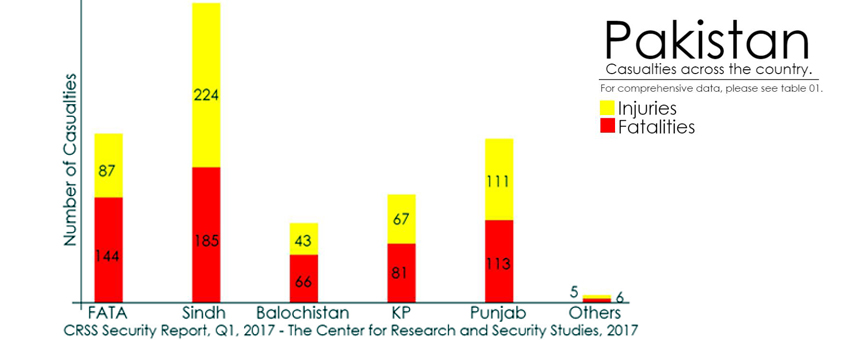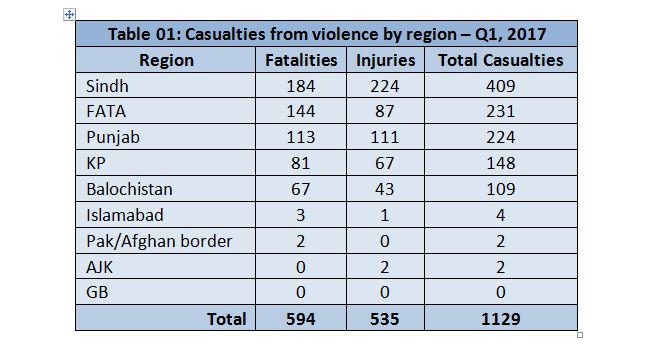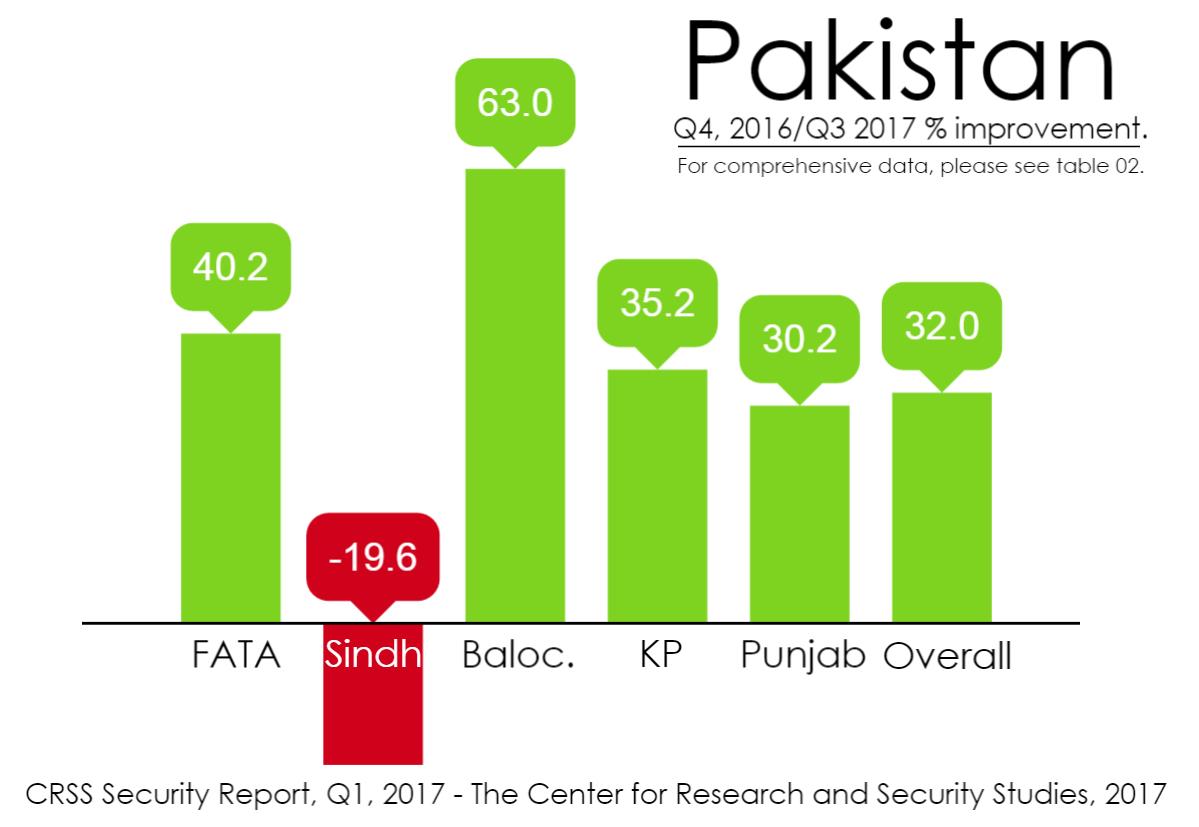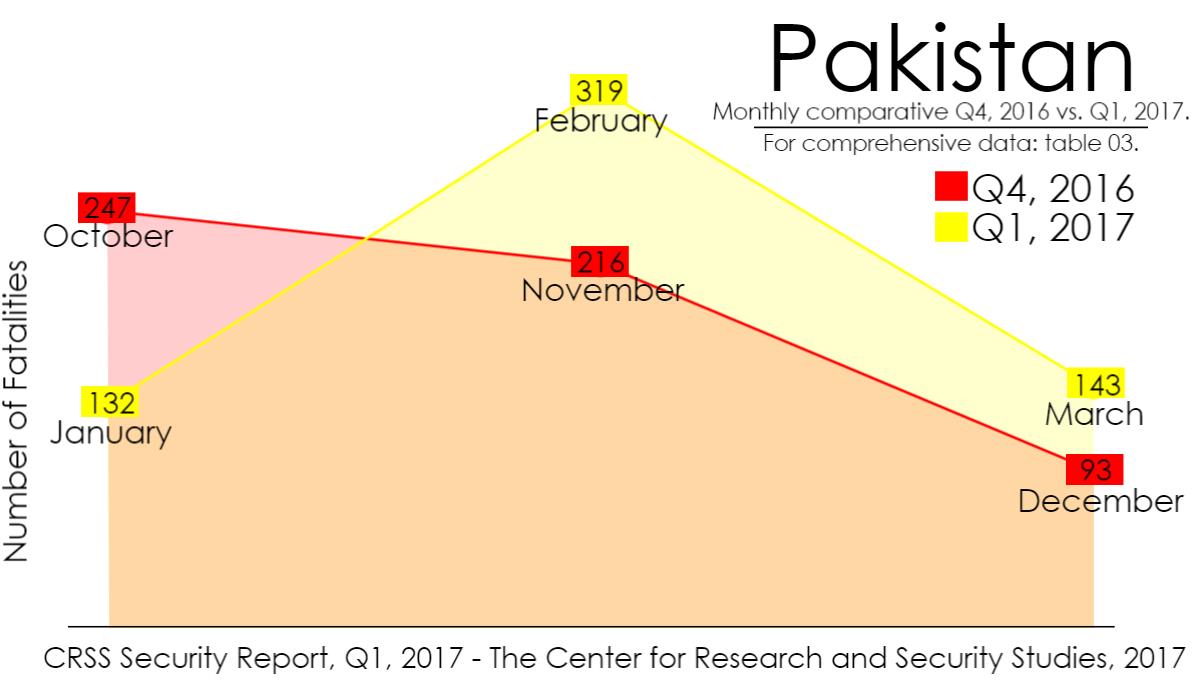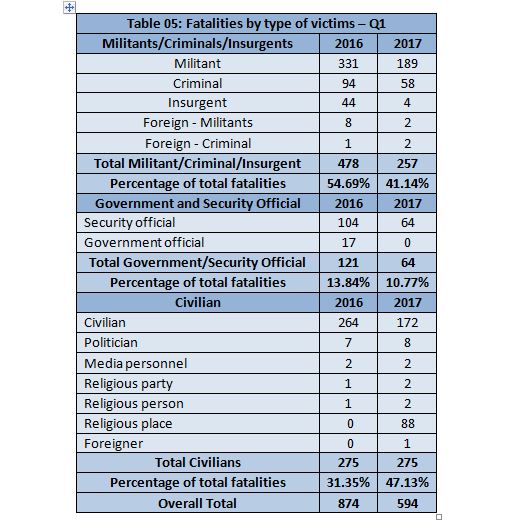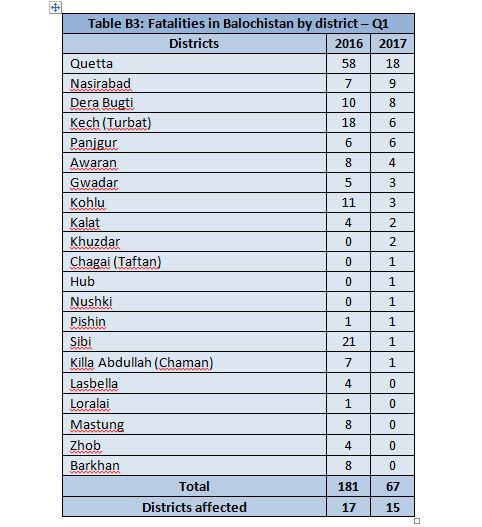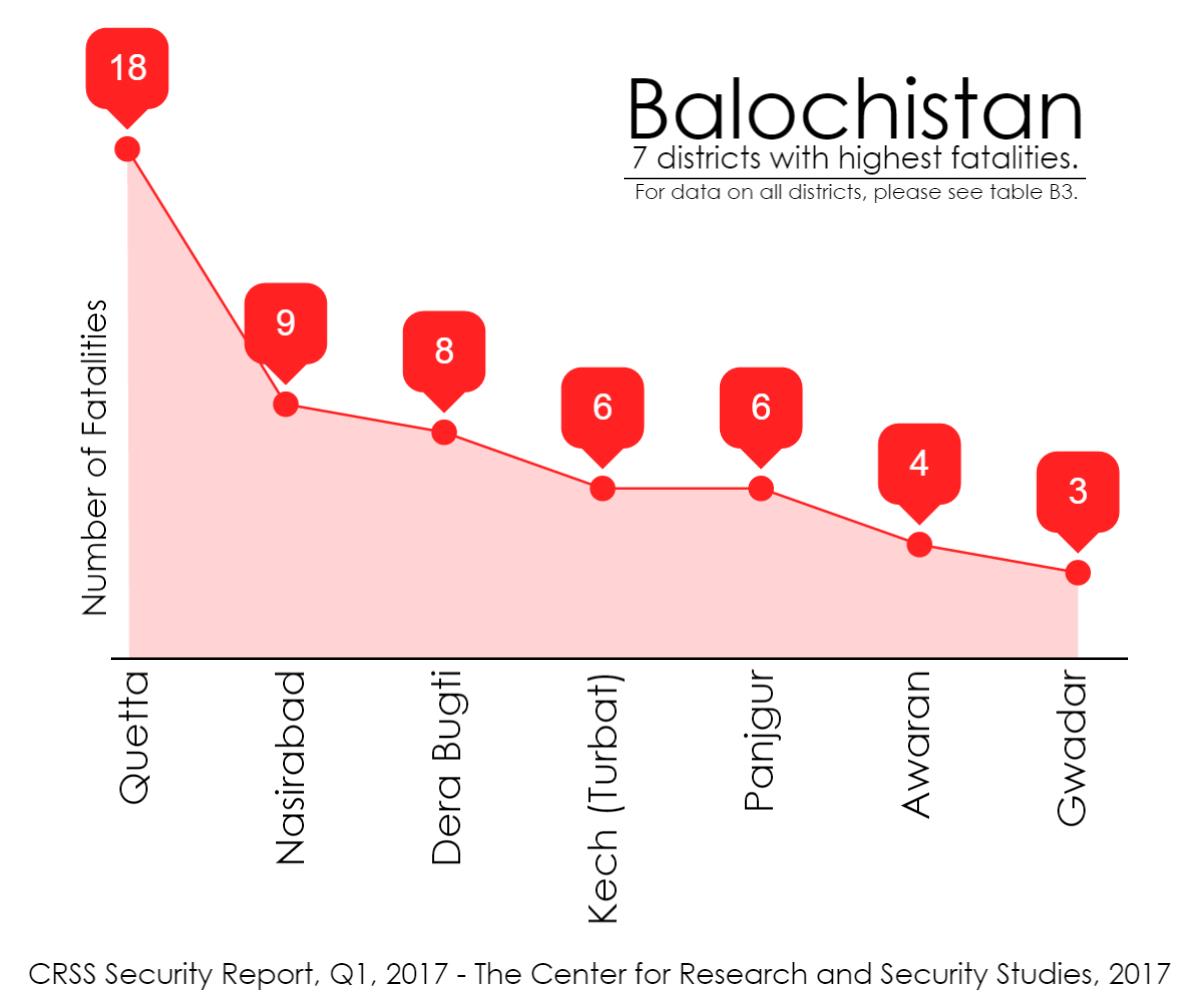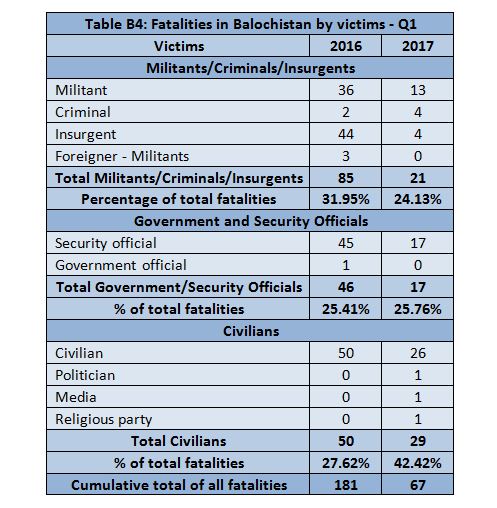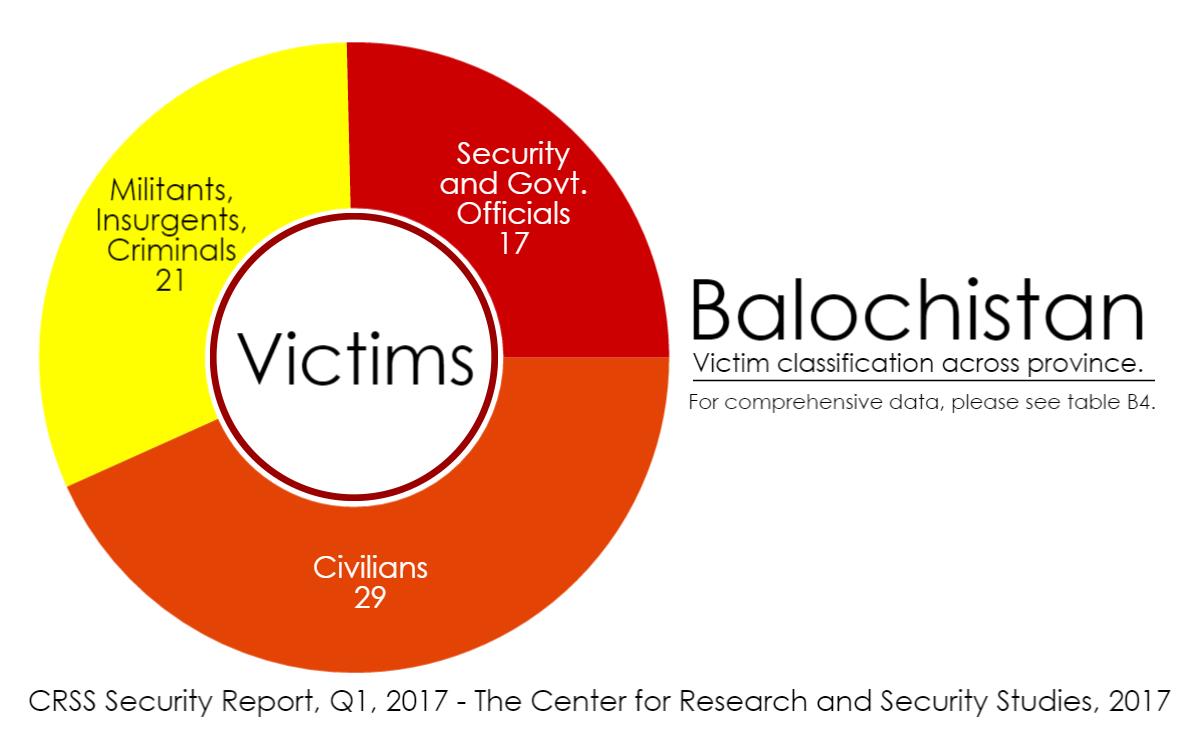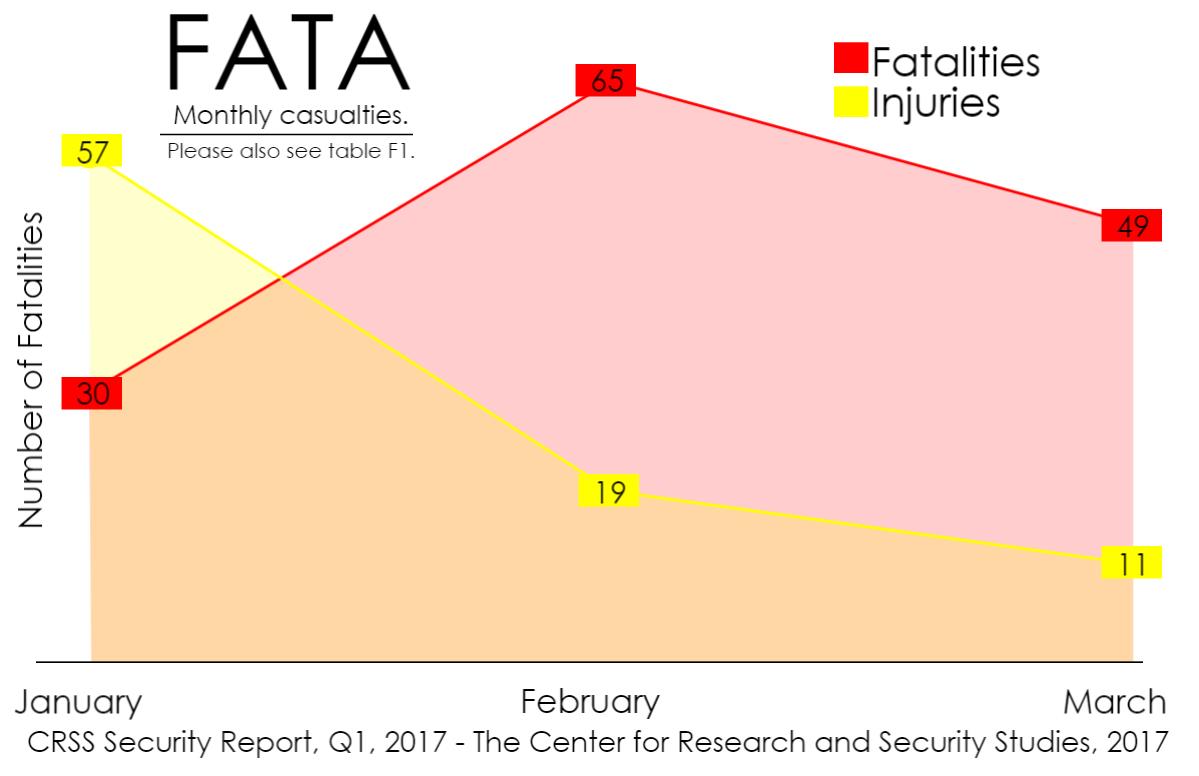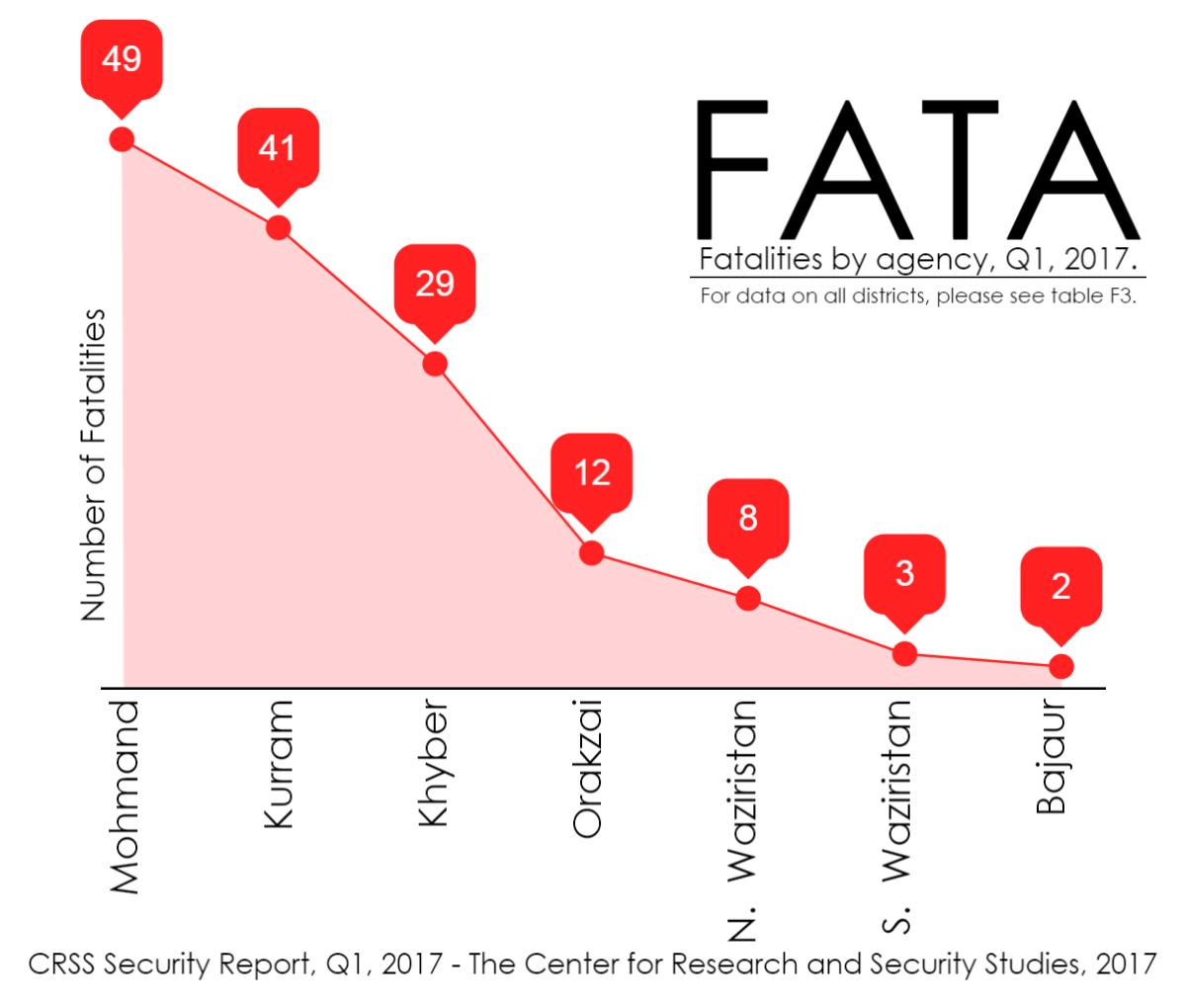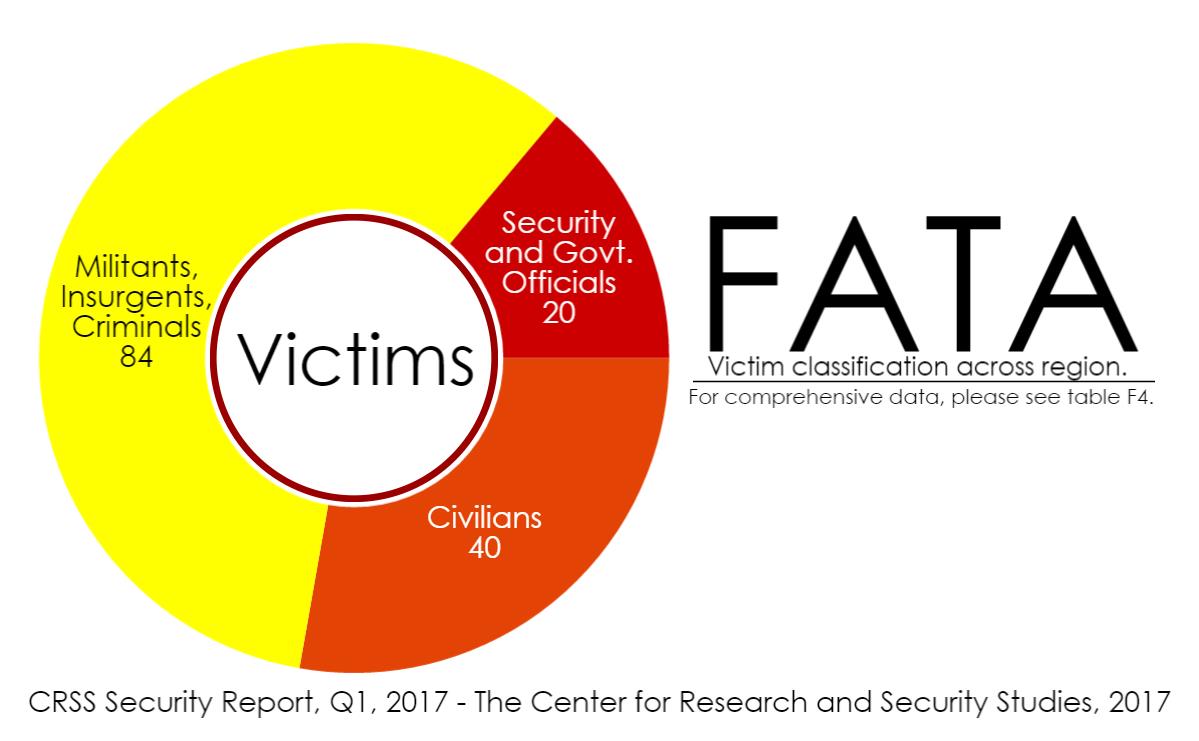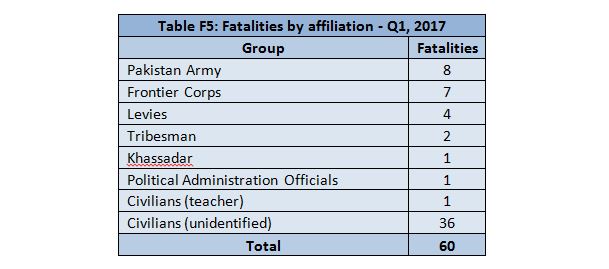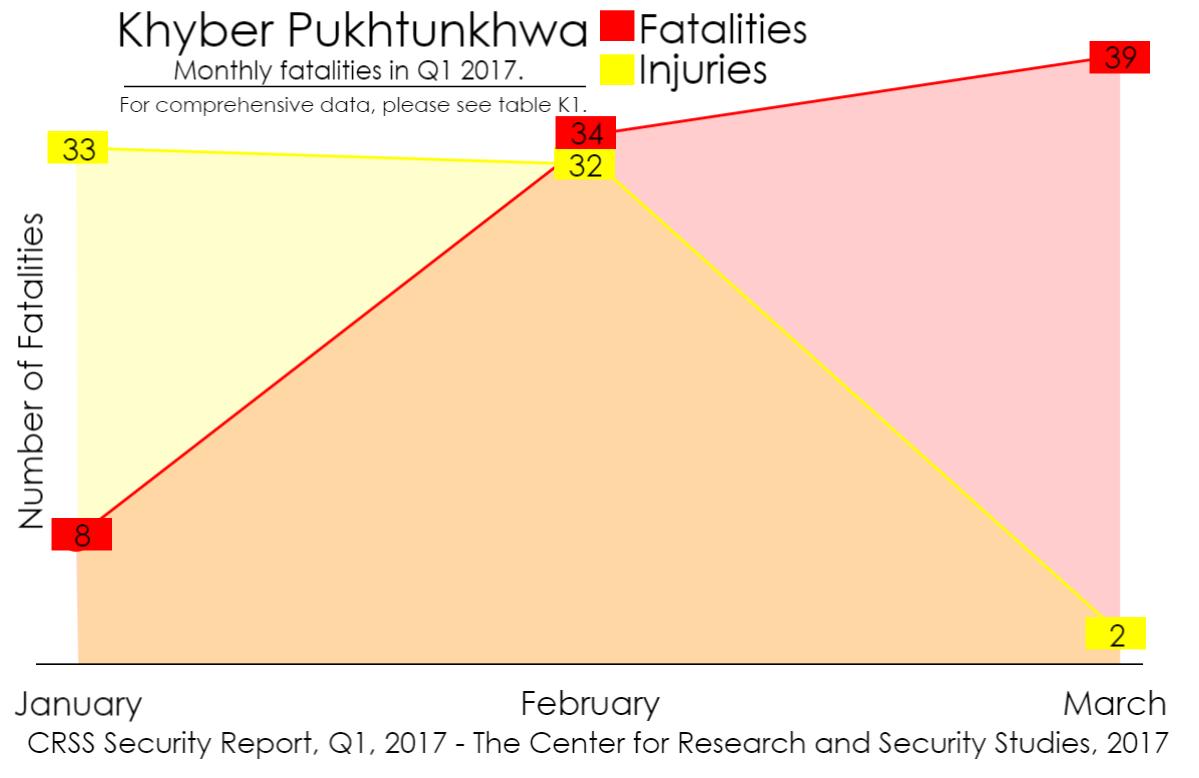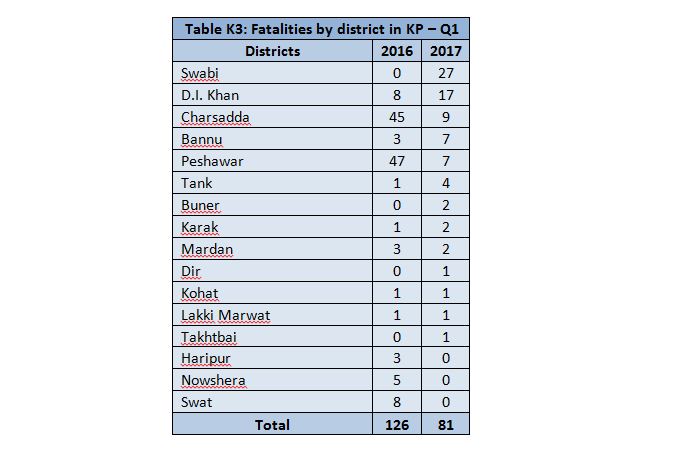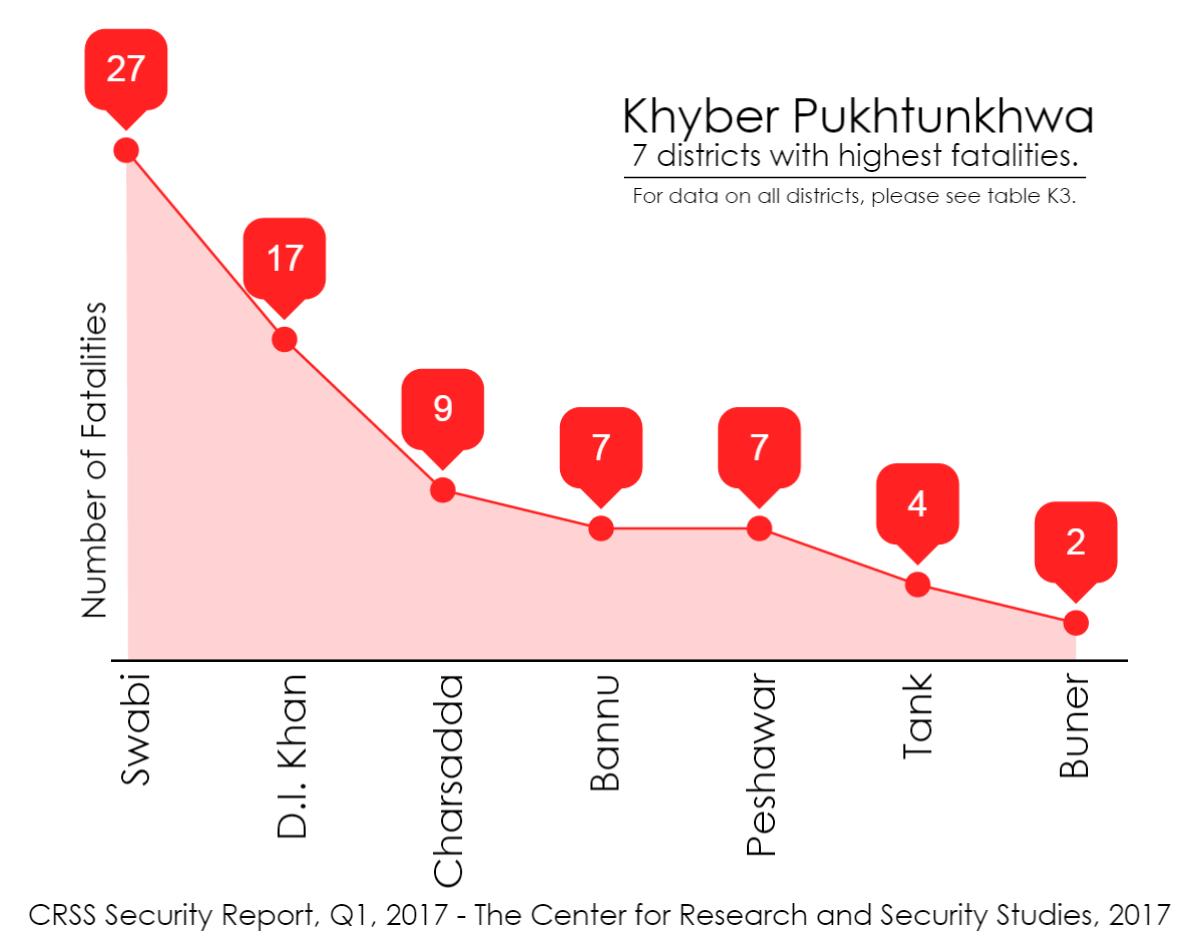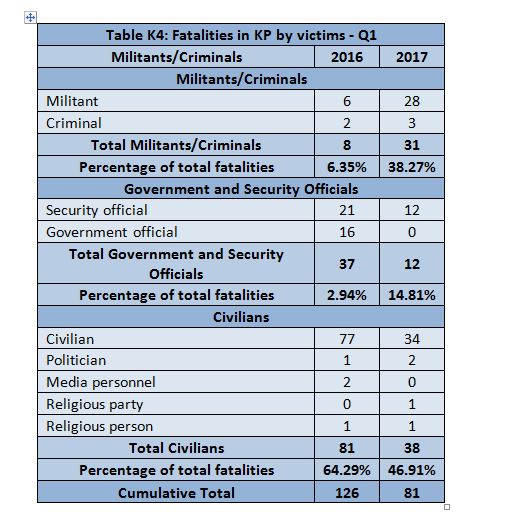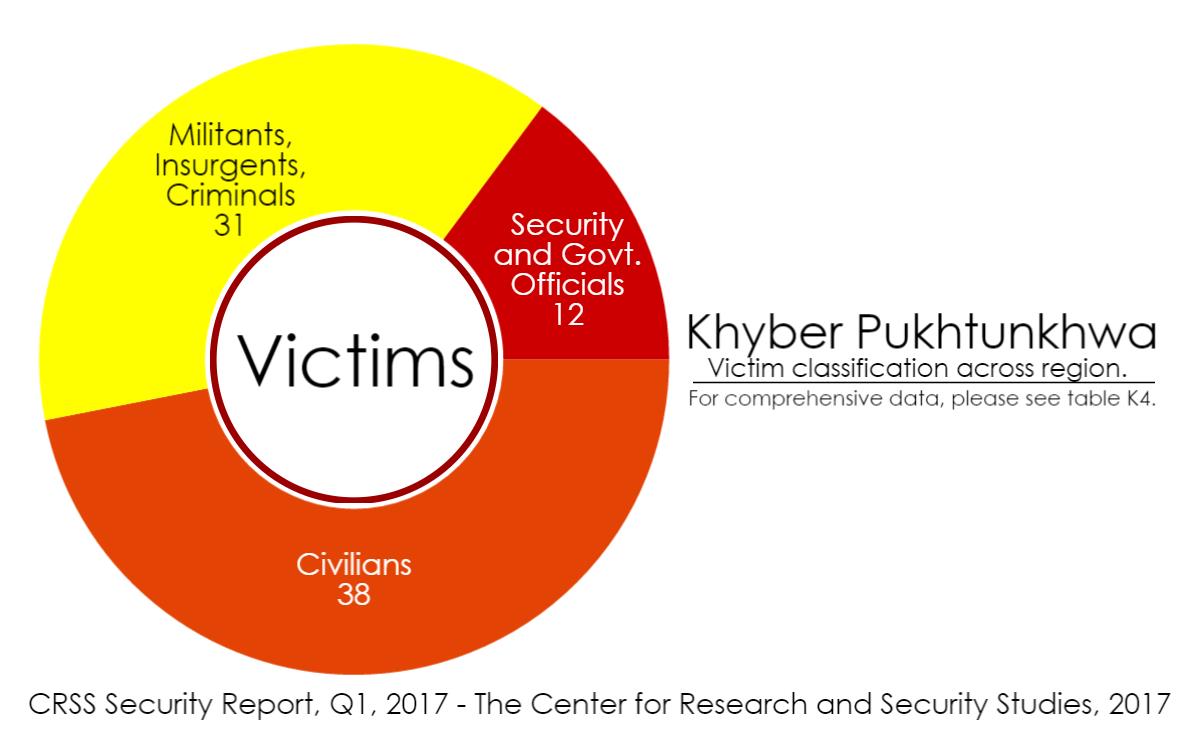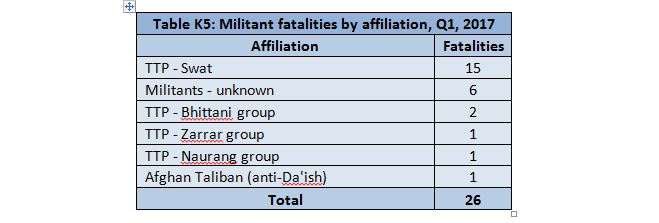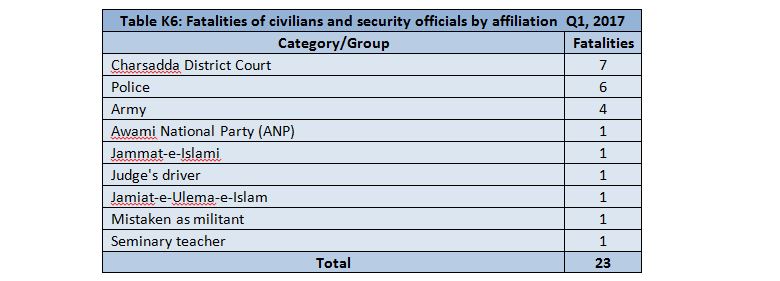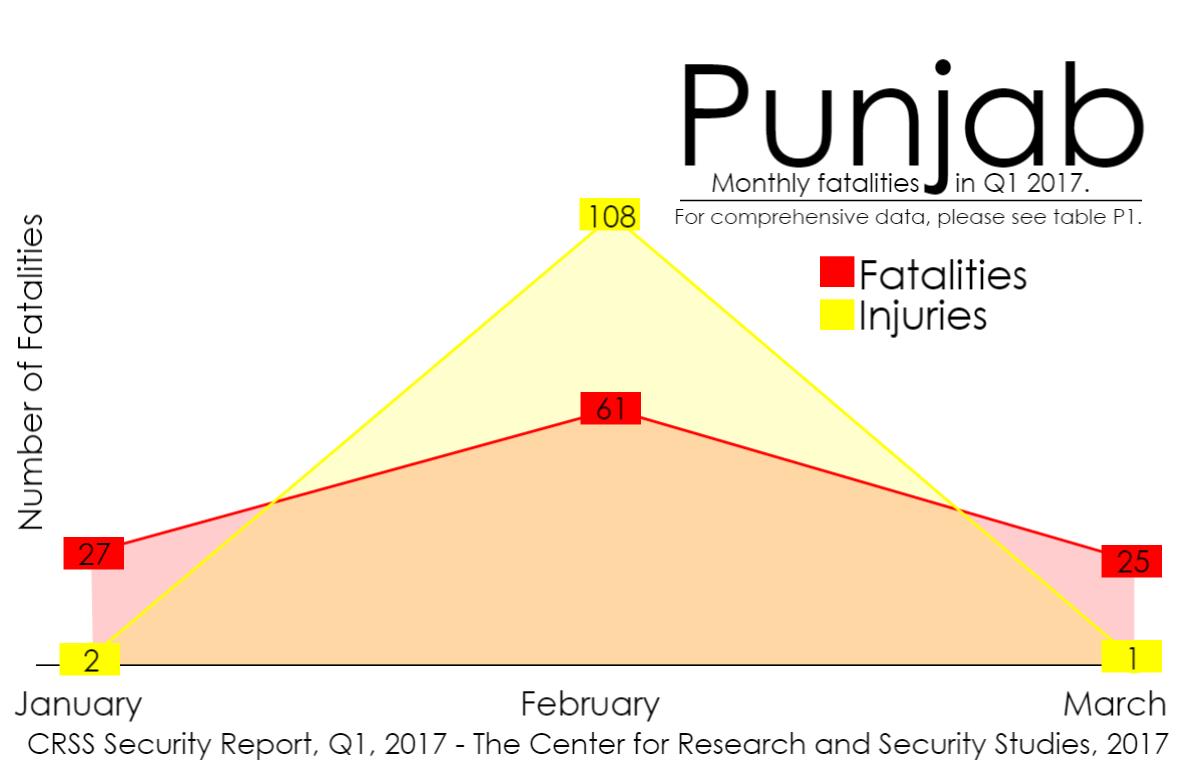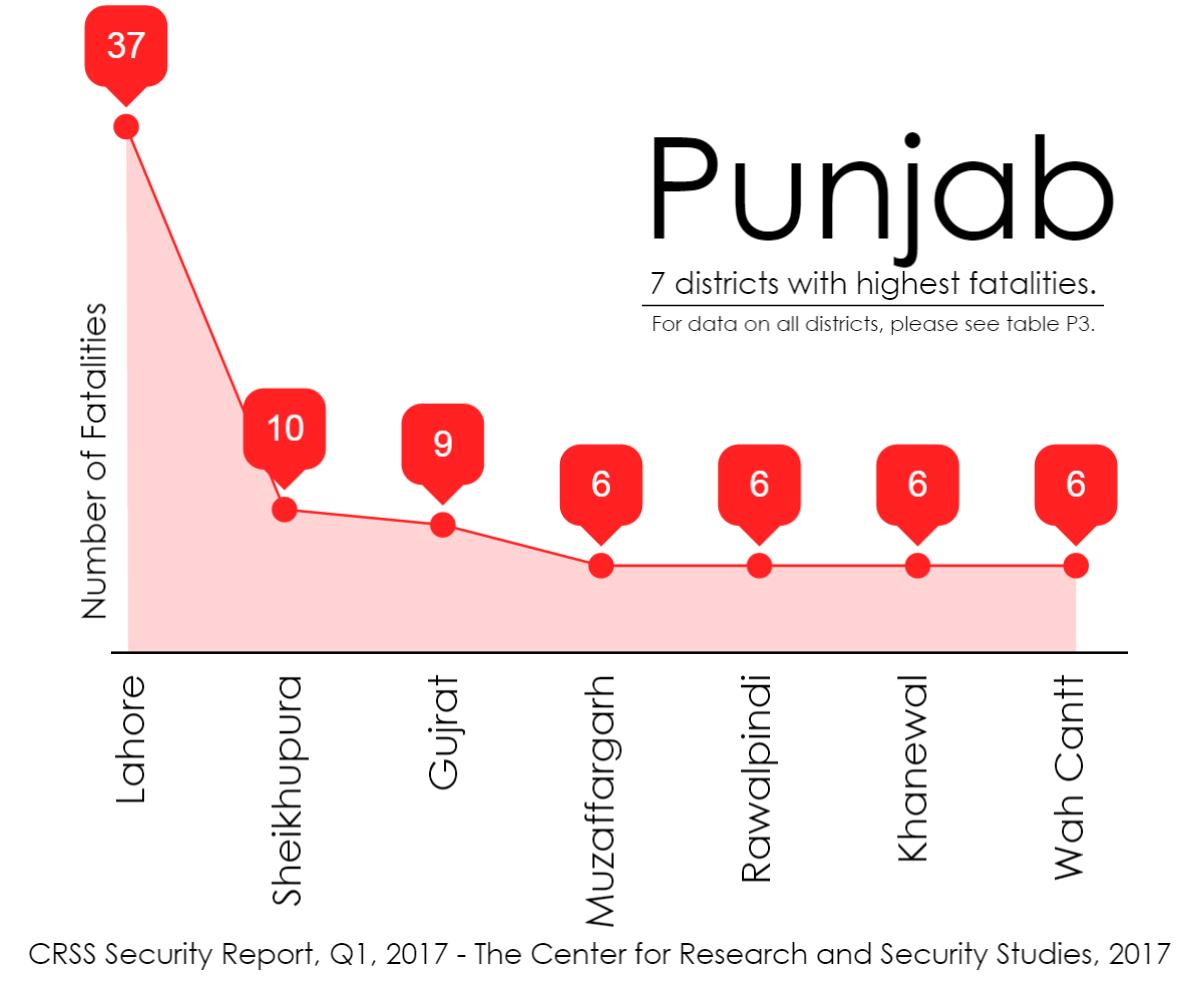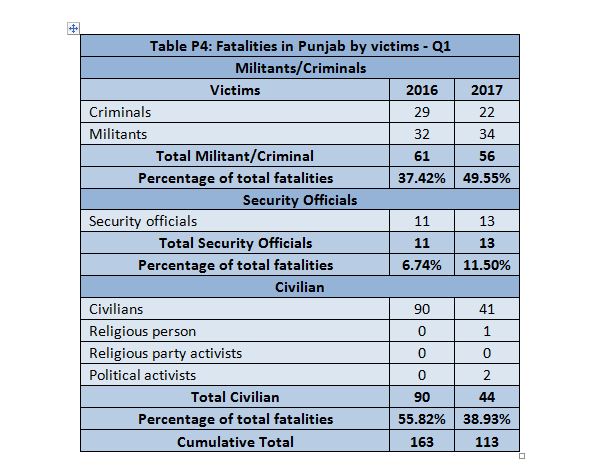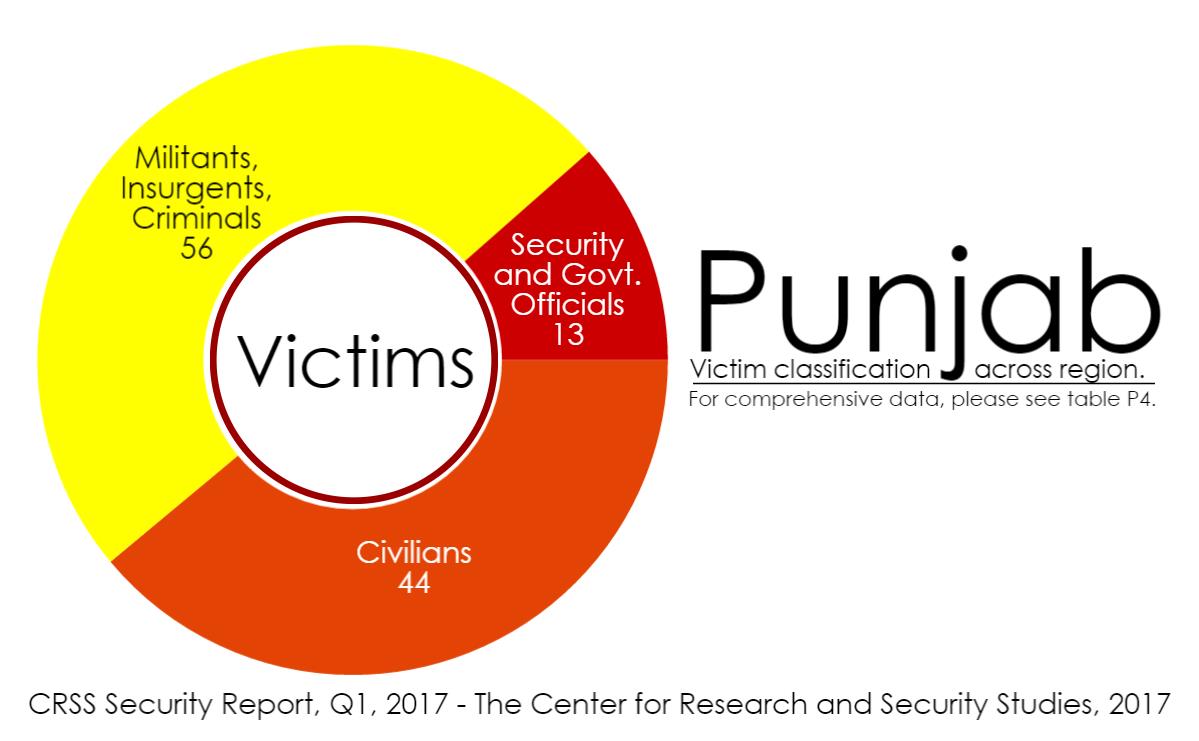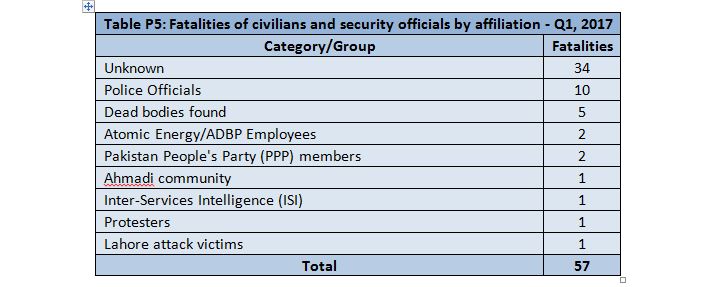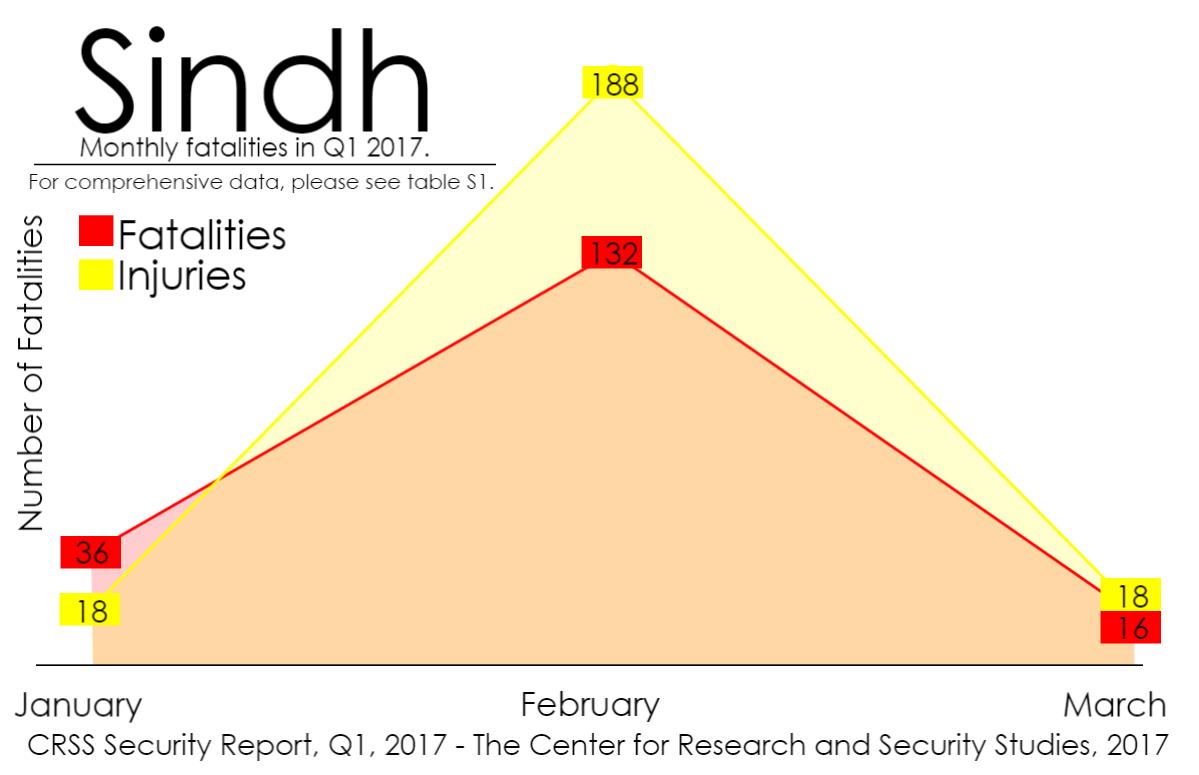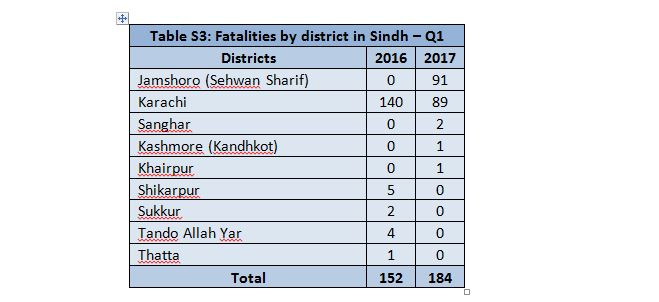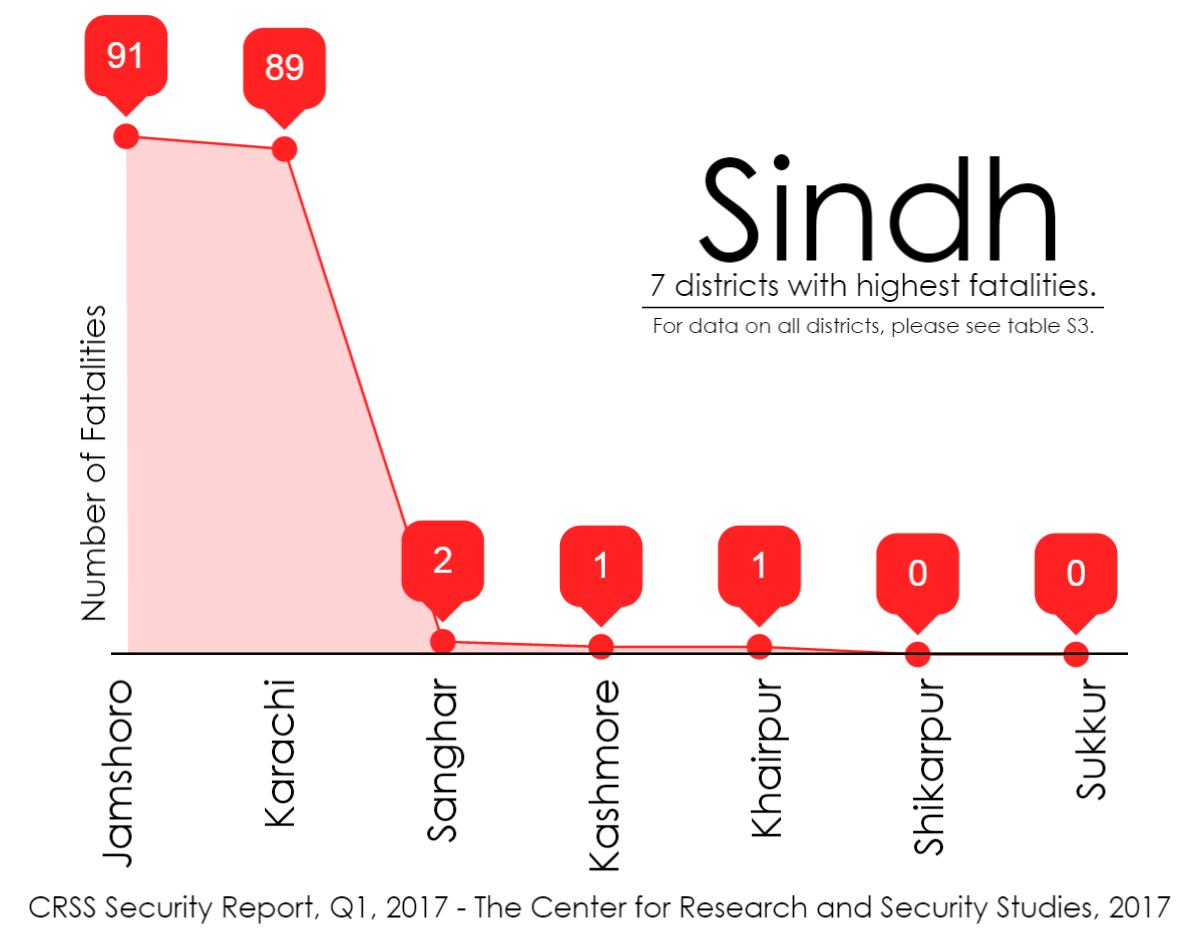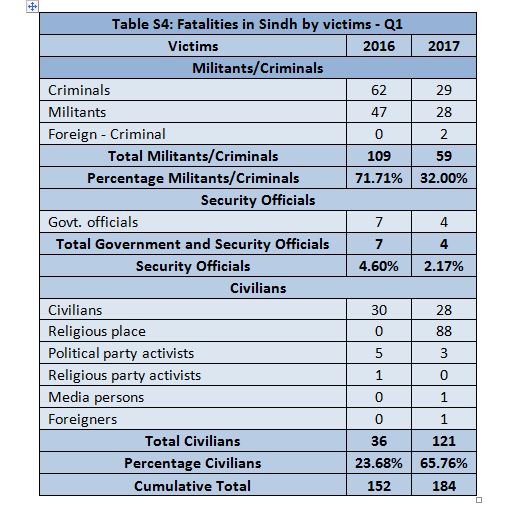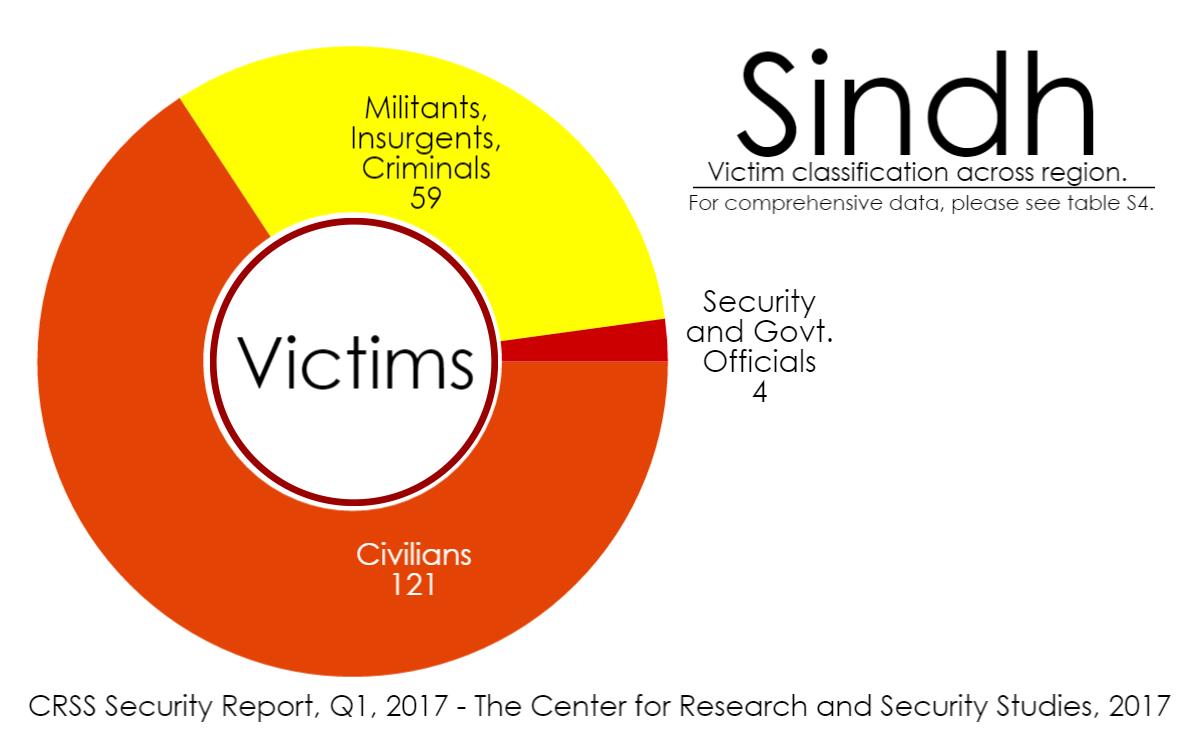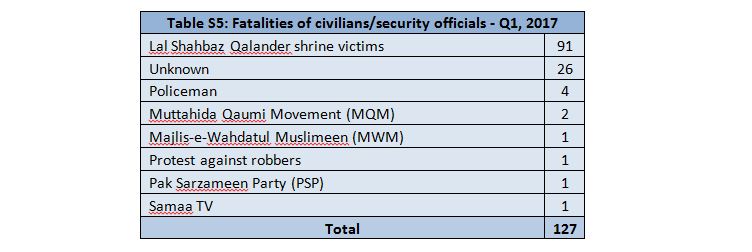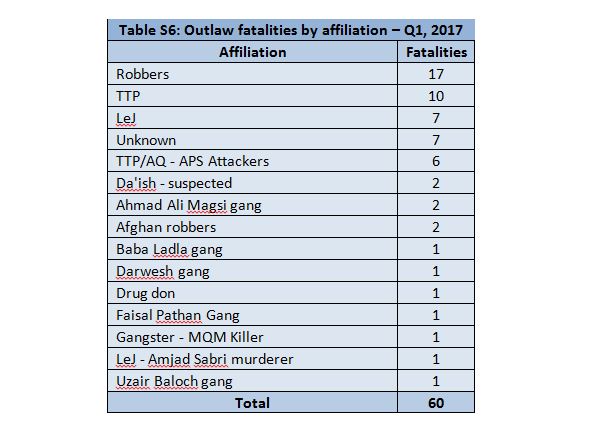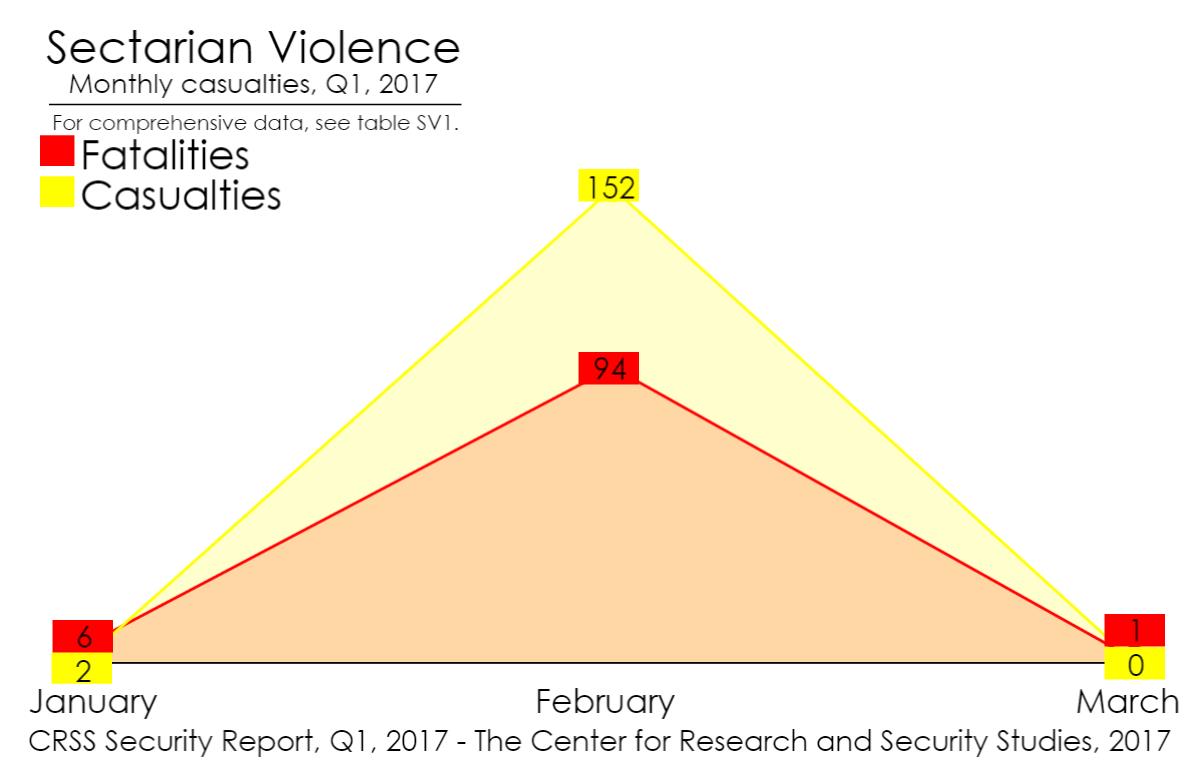Executive Summary:
After witnessing a marked drop in fatalities from violence during last year, the trend continued, despite a sudden upturn in violence during the second month in this quarter. The CPEC initiative, foreign intervention, and security lapses were some factors that led the militants and their supporters to strike using new strategies. Of all the regions in Pakistan, only Sindh showed an upsurge, when compared to data from last year’s first quarter. Every other province/region had declining amounts of violence-related casualties.
While the ongoing military operation against outlaws forced the militant outfits like Tehrik-e-Taliban Pakistan (TTP), Lashkar-e-Islami (LI), and Lashkar-e-Jhangvi (LeJ) to go into hiding, Da’ish (or Islamic State (IS)) also made itself known by claiming major suicide attacks at two Sufi shrines in Sindh and Balochistan.
In February, eleven coordinated attacks were reported across the country. Having lost thousands of militants in security operations, and with thousands more in custody, the militant ability to continue with such attacks was viewed as a shocking development and unprecedented given Pakistan’s recent gains.
Overall, the security situation continues to improve, although we are seeing more of a plateau in progress, as expected. It is hoped that with kinetic gains, the state apparatus also focuses on the softer side of things to try and eliminate extremism, which is the root cause of terrorism in the country.
To assess and evaluate what new challenges and threats are being faced by the country, this report makes use of the national print and electronic media sources. CRSS endeavors to ensure that the data is as accurate as possible within the available resources. However, it does not rule out errors and omissions, which are always a possibility in such public-source statistical work. Such mistakes, nevertheless, do not grossly affect the overall outcome and conclusions of this report. It must also be said that this work cannot take into account incidents of violence-related fatalities and casualties that go unreported.
Readers can approach CRSS for information related to this report. Alternately, you may send your queries to mail@crss.pk, directly to Mohammad Nafees, Senior Research Fellow, CRSS – the author of the report (mohammad.nafees@yahoo.com), or Zeeshan Salahuddin, Senior Research Fellow
Fatalities from Violence in Pakistan
During this quarter, there were 1,129 reported casualties (594 dead and 535 wounded) across Pakistan. Regionally, Sindh was the most violent province/region, followed by FATA, Punjab, and Balochistan.
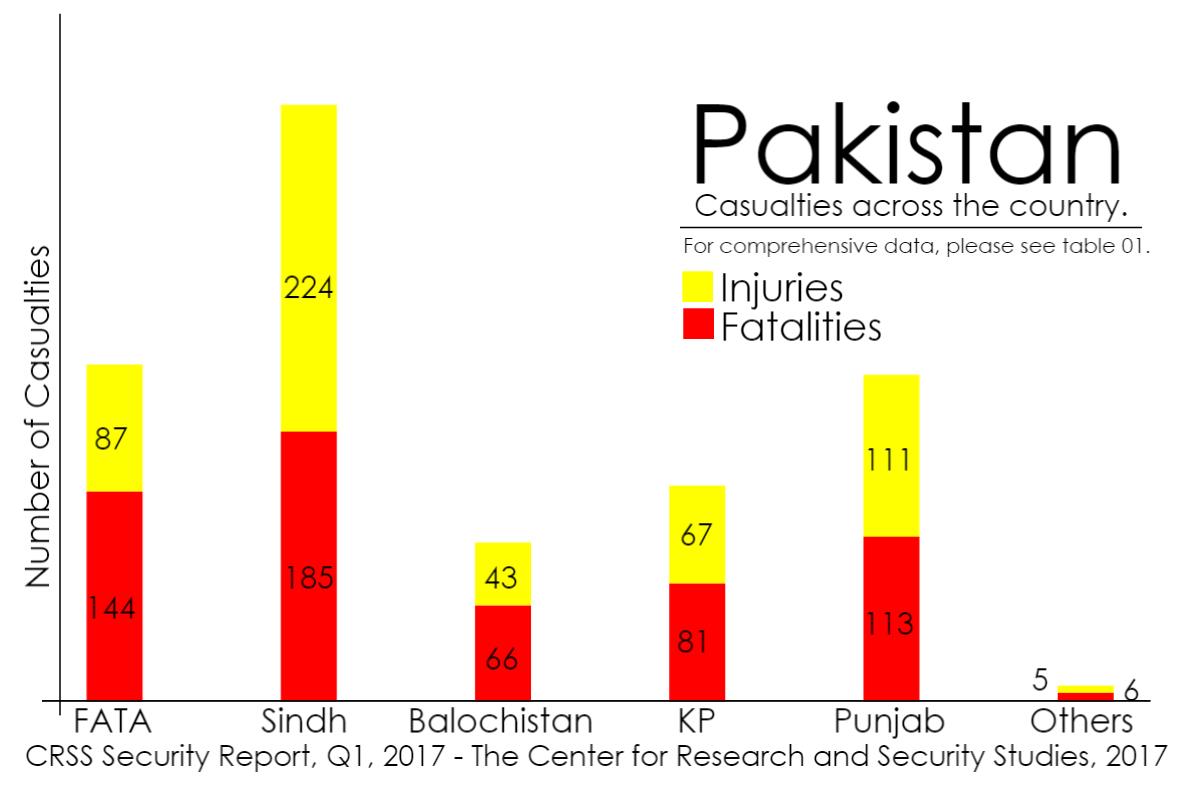 Fatalities in Sindh went up, when compared to Q1, 2016, and unlike the past, the violence in Karachi was not the principle factor. After a stark increase in violence in 2016, Balochistan saw a more than 60% drop in violence when compared against Q1, 2016. With the exception of Sindh, all other provinces recorded a drop in fatalities during this period (table 02). Two militants belonging to Afghan Taliban were targeted by a US drone strike on March 3, 2017 in the border areas of Kurrum Agency.
Fatalities in Sindh went up, when compared to Q1, 2016, and unlike the past, the violence in Karachi was not the principle factor. After a stark increase in violence in 2016, Balochistan saw a more than 60% drop in violence when compared against Q1, 2016. With the exception of Sindh, all other provinces recorded a drop in fatalities during this period (table 02). Two militants belonging to Afghan Taliban were targeted by a US drone strike on March 3, 2017 in the border areas of Kurrum Agency.
NOTE: green reflects percentage improvement in violence-related fatalities. Red reflects increase.
Comparative analysis of Q1, 2017 and Q4, 2016 figures reveals that the drop in violence achieved during the last quarter could not be sustained during this quarter. There was a nearly 7% upsurge in violence-related fatalities this year (table 03).
With a few exceptions, the fatalities from most forms of violence reduced this quarter when compared with the fatalities recorded in Q1, 2016. The fatalities from IED explosions, armed attacks, and skirmishes between security forces and outlaws were the only forms of violence that went up this quarter. Incidents of suspected encounters, custodial deaths, and robbery related fatalities also continued this quarter.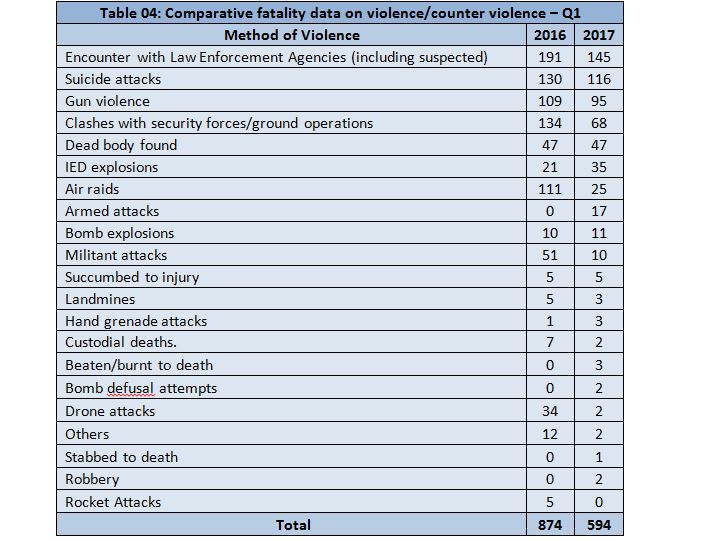
Despite a drop in fatalities when compared against Q1, 2016, the percentage of civilian fatalities went up from 31% to 47%. A major reason for this is the targeting of religious sites and shrines by militants. Desecration of holy places also falls under blasphemy law PPC 295[1] but no case has ever been registered against said militants. The militants, criminals, and insurgents had a marked drop in fatalities, from 478 in Q1, 2016 to 257 in Q1, 2017.
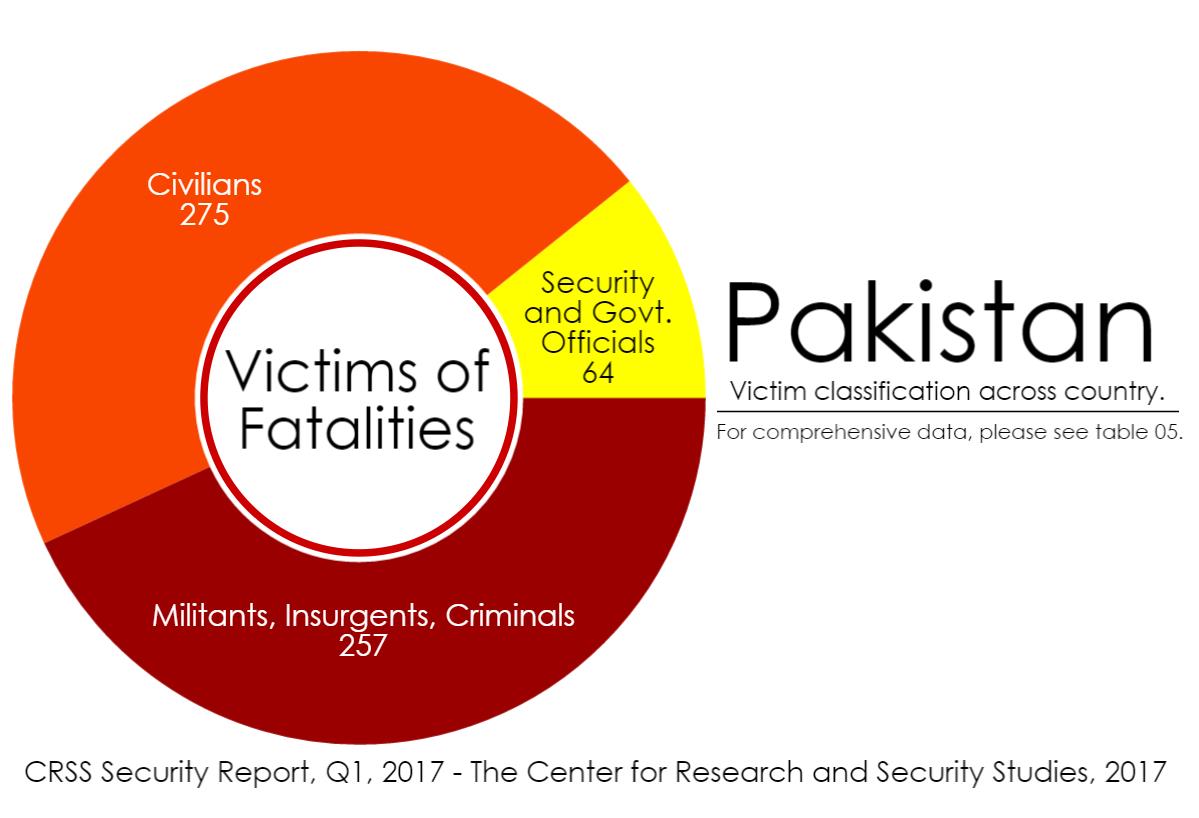 Balochistan
Balochistan
Balochistan had 110 casualties in this quarter (67 dead and 43 injured). The fatalities of these three months are roughly on par with the average monthly fatalities in 2016 (805).
Compared to first quarter of last year, Balochistan witnessed a more than 60% drop in fatalities from violence in every month of this year (table B2).
All districts of Balochistan reflected a significant decline in the fatalities during this quarter. Quetta, the provincial capital, as expected, recorded the highest number of casualties.
A closer look at the fatalities from violence in Balochistan reveals that despite a significant drop in violence, the beneficiaries of this improvement were not civilians. While the percentage of militants and criminals came down from 32% in Q1, 2016 to 24% in Q1, 2017, the civilian percentage went up from 28% in Q1, 2016 to 42% in Q1, 2017.
The militants and criminals that were eliminated in security operations in Balochistan were mostly reported as militants without any identification of their affiliation with any militant outfits. The same was the case with most of the insurgents that were killed in security operations. Only one of them was identified as Muhammad Rafiq, commander of BLF who was killed in security search in Kech. One “most wanted” militant was also killed in encounter in the Hazarganji area of Quetta but his name and affiliation were not disclosed.
Among security officials, policemen suffered the most fatalities. Most were murdered in target killings, while two lost their lives trying to defuse an IED in Quetta. One policeman was found dead after getting kidnapped a few days earlier.
The identity of the majority of civilian victims was unknown with the exception of a few.
 Only one militant outfit, Lashkar-e-Jhangvi al-Alami (LeJ-AA), claimed target killing of two persons from Shia Hazara community on Spini Road, Quetta while they were travelling in a taxi cab. Last year, during Q1, 2016, 30 people had lost their lives in incidents of violence that were claimed by TTP, Jundullah, and BLA (table B6). This is an indication of how the space for these groups has been significantly reduced through security operations.
Only one militant outfit, Lashkar-e-Jhangvi al-Alami (LeJ-AA), claimed target killing of two persons from Shia Hazara community on Spini Road, Quetta while they were travelling in a taxi cab. Last year, during Q1, 2016, 30 people had lost their lives in incidents of violence that were claimed by TTP, Jundullah, and BLA (table B6). This is an indication of how the space for these groups has been significantly reduced through security operations.
Federally Administered Tribal Areas (FATA)
In FATA, 231 persons (144 dead and 87 injured) were the victims of violence during Q1, 2017, with February as the most violent month of the quarter (table F1).
As opposed to the same quarter last year, the fatalities from violence had dropped nearly 40% in FATA during three months of this year when compared with the number of fatalities reported for the same period of last year (table F2).
On regional level, Mohmand, Kurram, and Khyber Agencies suffered the highest number of fatalities compared to other regions of FATA. The North Waziristan Agency, once known as the main sanctuary of militant outfits, shows nearly no signs of militancy. Major causes of fatalities in FATA were security operations, armed attacks by the militants, suicide attacks, cross border attacks, and IED/bomb explosions.
FATA also had an increase in the percentage of civilian fatalities during this quarter compared Q1, 2016. In case of security personnel, not only the percentage but their number of fatalities also went up this quarter while the militants and criminals witnessed a nearly 30% reduction in their fatalities (table F4). The militants who fled across the border soon after Operation Zarb-e-Azb, now appear to have reorganized and regained necessary strength to strike back. They carried out seven attacks from across the border in Mohmand, Kurram, and Khyber agencies resulting in clashes between the army and militants leaving 34 militants dead and 6 soldiers martyred.
The security personnel belonging to Pakistan Army and Frontier Corps (FC) had the highest number of fatalities during this quarter in FATA, in addition to a large number of unknown civilians (table F5).
The affiliation of the majority of militants eliminated in FATA during this quarter was unknown because they were mostly cross-border attackers.
The banned militant outfits that claimed responsibility for various terror attacks in FATA were mostly the splinter groups of TTP and LeJ, and most were joint claims, showing a growing nexus of inter-group coordination (table F7).
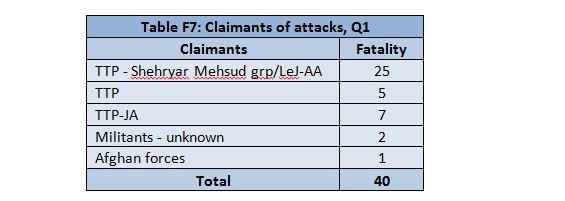 Khyber Pukhtunkhwa (KP)
Khyber Pukhtunkhwa (KP)
KP recorded 148 casualties of violence (81 dead and 67 injured) during this quarter with February and March showing an escalation in fatalities (table K1).
Although the year started with a marked decline in violence in KP, the next two months proved to be violent. Still, the overall drop in violence was close to 40% this quarter when compared with the figures of the same quarter of 2016 (table K2).
For the first time in last four years, the provincial capital of KP, Peshawar, was found to have least affected of violence among all other districts of the province. Swabi district replaced Peshawar with highest number of fatalities from violence followed by D.I.Khan, Charsadda, and Peshawar (table K3).
Another change is the increase in the number and percentage militants’ fatalities during this quarter when compared with the same quarter of the last year. The fatalities of the security personnel reduced in number but not in terms of percentage while the civilian’s fatalities reflected a decrease of nearly 20% (table K4).
Most of the militants eliminated in KP were reported as affiliated with different splinter groups of TTP and the highest number of them belonged to the TTP-Swat group. Some militants belonging to unknown groups of TTP were also eliminated during this quarter (table K5).
Among the civilian and security personnel, judiciary was a frequent target of the militants (table K6).
The splinter groups of TTP claimed responsibility for some of the terror attacks carried out in KP during this quarter (table K7).
 Punjab
Punjab
Punjab lost 113 lives, and another111 suffered injuries because of violence. The month of February had the highest number of casualties (table P1).
The fatalities from violence in Punjab were 30% lower than the same period last year (table P2). However, when compared against the previous quarter (Q4, 2016), the fatalities rose by about 40%.
The provincial capital, Lahore, had the highest number of fatalities from violence during this quarter. The number of districts that experienced violence went up from 12 districts in Q1, 2016 to 21 in Q1, 2017, but the number of fatalities reduced (table P3).
The loss of civilian lives to violence in Punjab was significantly reduced during this quarter than in the same period of the last quarter. In contrast, the fatalities of outlaws went up by 10%, as well as the fatalities of the security and government officials.
Policemen suffered the most casualties during this quarter. Two high level police officials, SSP Operations Zahid Gondal of Punjab Police, and DIG Traffic Lahore Capt. (retd) Ahmad Mobin were among the six policemen who lost their lives when a suicide bomber detonated outside Punjab Assembly in Lahore on February 13, 2017. Seven civilians also lost their lives in this incident, while 85 were wounded.
The security operations carried out against the outlaws eliminated a large number of militants that were affiliated with Jamat-ul-Ahrar (JuA), a splinter group of TTP. Street crime seems to be on the rise in Punjab. Within three months, seven robbers and two suspected car thiefs, two dacoits, and a robber suspected of killing a policeman were killed in Punjab (table P6).
JuA targeted high level police officials in front of the Provincial Assembly in Lahore. Da’ish Al-Bakistan was a new name used by the killers of Omar Mubeen Jilani, ISI intelligence officer and nephew of former CJP Tassaduq Hussain Jillani.
Sindh
Sindh was the only region that witnessed a rise in violence-related casualties during this quarter. A major incident that contributed to this upsurge was the suicide attack at Lal Shah Shahbaz shrine in Sehwan Sharif that left more than 90 persons dead. Sindh had 409 casualties (185 dead and 224 wounded) during Q1, 2017 (table S1).
When compared against number of fatalities recorded in Q1, 2016, the fatalities were 20% higher (table S2). The month of February had the highest number of fatalities.
Two districts of Sindh had the highest number of fatalities during this quarter. The suicide attack at Sehwan Sharif caused more fatalities than the total number of fatalities recorded during three months in Karachi (table S3).
There was a marked decline in the number and percentage of militant and criminal fatalities. The civilian accounted for 65% of the total fatalities, compared to 24% recorded in the first quarter of last year. The percentage of security personnel’s fatalities also declined (table S4).
Common people gathered at Lal Shahbaz Qalander’s shrine were the largest group of victims of violence in Sindh during this quarter. As many as 88 persons were reported killed on the day of incident and three more succumbed to their injuries later on.
Among the outlaws who lost their lives during this quarter, the highest number was of robbers, followed by TTP militants, LeJ, TTP/AQ militants suspected of having involvement in APS attack, Da’ish, and others (table S6).
Incidents of robbery related fatalities are constantly rising in Karachi and so are the lynching incidents. Out of 17 robbers who lost their lives during this reporting time, 14 were killed in encounters and 3 of them lynched by a mob when they were caught red-handed. Two robbers were beaten to death in Landhi and Korangi while one of them was burnt alive in Korangi. One female and three male robbers were severely beaten by mob in Korangi and Orangi. Two Afghan nationals were also killed when they attempted a robbery. On February 22, 2017, over 200 people protested against growing robberies and theft incidents at Islam Chowk area of Orangi Town. As the demonstration turned violent it resulted in injuries of five protesters, one of them succumbed to his injuries at the hospital.
Militants belonging to banned outfits like TTP, LeJ, and AQIS were also killed in Karachi during this quarter.
For the first time, a major suicide attack at Sehwan Sharif, a remote area of Sindh, took place whose responsibility was accepted by Daish, a militant outfit whose presence was quite often denied by the government. In the last quarter (Oct-Dec 2016), Daish had claimed responsibility for the suicide attack at Shah Norani shrine in Khuzdar, Balochistan.
 Azad Jammu and Kashmir (AJK), Islamabad, and Gilgit Baltistan (GB)
Azad Jammu and Kashmir (AJK), Islamabad, and Gilgit Baltistan (GB)
While GB remained safe from violence during this quarter, Islamabad and AJK did experience some incidents of violence.
In AJK, a Shia cleric and his wife were shot and injured by unknown assailants in Muzaffarabad. It remains unclear whether the shooting was a sectarian attack or motivated by personal enmity. The secretary general of the AJK chapter of Majlis Wehdatul Muslimeen (MWM), Allama Tasawwar al Jawadi, 38, was on his way to visit his in-laws in the town of Garhi Dupatta along with his wife, 32, when their motorcycle was intercepted by a black Corolla.
In Islamabad, three fatalities were reported. One was killed in an encounter, while two dead bodies were found.
 Sectarian Violence
Sectarian Violence
During this quarter, as many as 254 persons were victims of sectarian violence of which 101 were killed and 154 were wounded (table SV1).
Last year during the same period, 79 were killed in sectarian violence. This year, that number has jumped to 101 in the first quarter, an over 25% increase. Also bear in mind that several incidents of potential attacks were also reported that caused no casualties, such as finding and defusing a bomb nexr to an Imambargah wall in Karachi.
The province of Sindh had the highest number of casualties of sectarian violence during this period followed by KP, Balochistan, and Punjab. In Sindh, the suicide attack at the Sufi shrine of Lal Shahbaz Qalandar was one of most fatal attacks of the year that left 91 persons dead and 150 injured. In Karachi, two persons from Shia community were the victims of target killings in Nazimabad and Gulistan-e-Jauhar.
In Balochistan, two persons from Shia Hazara community in Quetta and a Hindu trader in Killa Abdullah were killed in target killing incidents.
In Khyber Pukhtunkhwa, one Sunni teacher of a seminary was found dead in Chamkani, Peshawar and three persons from Shia community were gunned down in Prawa Tehsil of D.I. Khan.
In Punjab, a prominent local leader of the Ahmadi community and a relative of Nobel laureate Abdus Salam, was gunned down in Nankana Sahib.
In AJK, a Shia Aalim, Allama Taswar Jawadi and his wife were attacked by unknown people leaving them critically injured.
Three militant outfits claimed responsibility for most of the sectarian attacks reported from the country (table SV4). Da’ish claimed the suicide attack at Sufi shrine of Lal Shahbaz Qalandar while LeJ-AA claimed responsibility for the target killing of two persons of Shia Hazara community in Quetta. After staying dormant for more than a year, LeJ claimed responsibility for the target killing of an Ahmadi community leader in Nankana Saheb.
The largest number victims of sectarian violence during this quarter were Sufi devotees followed by the Shia sect (table SV5). In the last quarter, the Sufi devotees had the highest number of fatalities as well.
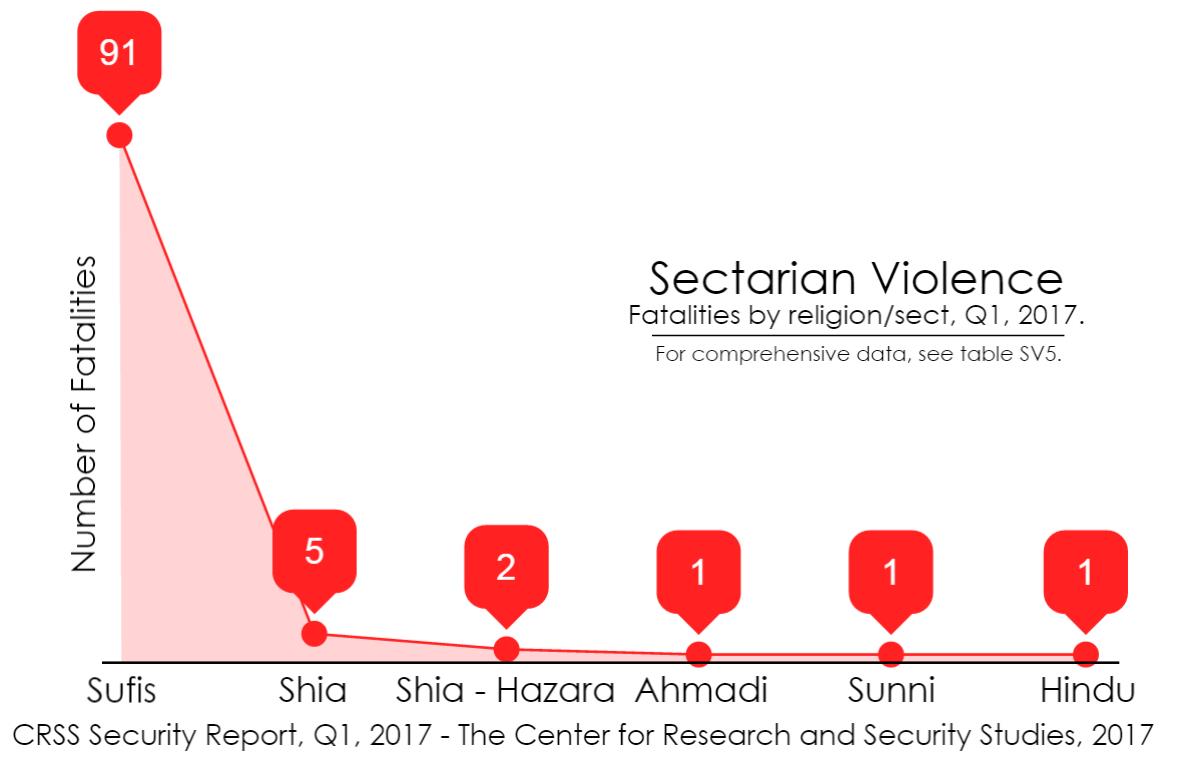 Conclusion
Conclusion
Da’ish has made its presence known by claiming two suicide attacks within last six months. While the ongoing operation against Da’ish in Syria and Iraq is reclaiming territory, the appearance of Da’ish, or Da’ish affiliates, in Pakistan is matter of much concern. Reports indicate that militants from the TTP and other proscribed outfits are now shifting their loyalties and joining Da’ish. If the trend continues it may transform the scenario of militancy in the country.
Instead of choosing urban centers for violence as has been the case in the past by other militant outfits, Da’ish has begun attacking in the less guarded, less settled areas, reflecting a new strategy. It raises questions about the efficacy and effectiveness of the security operations that were carried out thus far. However, it must be said that after the sudden upsurge of violence in February, we did not see similar coordinated strike in a concentrated period of time again.
The sectarian violence on sect basis has assumed more prominence in the country now. The suicide attacks at Sufi shrines have resulted in the deaths of attendees that hail from multiple identities. The civil and military leadership needs a review of all their policies and strategies to come up with a better understanding of what they have missed in their resolve to wipe out the militancy from the country, particularly in the sectarian sphere.
[1] PPC295: Injuring or defiling places of worship, with intent to insult the religion of any class.

